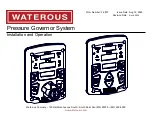
- 9 -
PROCEDURE DI TEST ED INFORMAZIONi
1. Mentre una balla si sta formando nella camera di
pressatura, il BHT-1 legge e fa la media di diversi test e
visualizza i risultati ogni due secondi. Normalmente, le
letture di umidità varieranno di diversi punti
percentuali in una sola balla. Le Andane non hanno
mai uguale umidità da cima a fondo. Di solito, saranno
più umide nella parte superiore, a causa della rugiada,
o più asciutte per via del sole e del vento. Di solito, il
fieno che è pronto per essere pressato varia meno del
fieno che non è ancora pronto.
2. Letture continue sia dell’unità BHT-1 che delle unità
di altri produttori saranno generalmente superiori alle
letture di tester palmari, portatili o a sonda. Il BHT-1
probabilmente leggerà circa 2-3 punti percentuali in
più, in media, e letture ancora più elevate per le balle
squadrate più grandi, a seconda delle condizioni.
3. Non essere preoccupato se esistono queste
differenze. Piuttosto svilupperai una certa pratica per
stabilire un intervallo accettabile di umidità per la
pressatura, sulla base delle letture del tuo contatore.
Stabilisci un range appropriato, valutando una
posizione per le nuove balle con un tester a sonda
portatile, come un HT-PRO o un DHT-1.
4. L’umidità del fieno può variare considerevolmente
da una parte all’altra di un campo. (Vedere le
Informazioni di controllo) Se l'intervallo di umidità
visualizzata dal BHT-1 aumenta sopra i limiti
accettabili, smetti di pressare le balle e analizza le
condizioni del campo per scoprirne il motivo. Non puoi
continuare a pressare in questa zona del campo.
VARIABILI CHE INFLUENZANO LE LETTURE DI
UMIDITA’
Comprendere le molte variabili che influenzano le letture
del vostro BHT-1 sarà di aiuto per ottenere il massimo dal
tuo strumento.
1. Condizioni del campo: l'umidità del suolo, aree di
maggiore o minore altezza, depressioni e zone
ombreggiate sono tutti fattori che influiscono
sull’umidità del fieno all’interno dello stesso campo.
2. Varietà di fieno, rapporti foglie-steli, la maturità delle
colture e differenti tagli contribuiscono alle più diverse
distribuzioni di umidità nelle piante di fieno.
3. Variabili della mietitura: Densità della balla,
dimensioni e forma dell’andana, ora del giorno,
temperatura del fieno e condizioni climatiche globali
influenzano le letture di umidità. L’alta umidità con cielo
coperto contribuisce a maggiori variazioni di letture di
umidità rispetto ad una giornata secca di sole con una
leggera brezza.
4. Alcuni conservanti aumentano inizialmente la
conduttività. Finchè il conservante non è completamente
assorbito, solitamente in 1-2 giorni, le letture possono
essere di 2-4 punti al di sopra di quelle dello stesso fieno
non trattato.
TESTING PROCEDURE AND INFORMATION
1. While a bale is being formed in the bale chamber, the
BHT-1 reads and averages several tests and displays
these results every two seconds. Typically, moisture
readings will vary several percentage points in a single
bale. Windrows are never the same moisture from top
to bottom. Usually, they will be wetter at the top,
because of dew, or drier, because of sun and wind.
Usually, hay that is ready to bale varies less than hay
that is not yet ready.
2. Continuous readings from the BHT-1 and other
manufacturers’ meters will usually be higher than
reading from handheld, portable or probe testers. The
BHT-1 will probably read about 2-3 percentage points
higher on average, and even higher for large, square
bales, depending on conditions.
3. Do not be concerned that these differences exist.
Rather, develop a feel for an acceptable range of
moisture for baling, based on your meter’s readings.
Establish an appropriate range by spot checking new
bales with a portable probe tester, such as a HT-PRO or
DHT-1.
4. Hay moisture can vary considerably from one part of a
field to another. (See Testing Information.) If the
moisture range displayed by the BHT-1 increases above
your acceptable limits, stop baling and analyze the fi
eld conditions to determine why. You may not want to
continue baling in this area of the field.
VARIABLES AFFECTING MOISTURE READINGS
Understanding the many variables that affect the
readings of your BHT-1 will help you get the most from
your meter.
1. Field conditions: soil moisture, high or low areas,
swales and shady areas all affect hay moisture within
the same field.
2. Hay varieties, leaf-to-stem ratios, crop maturity and
different cuttings contribute to widely varying moisture
distribution in hay plants.
3. Harvesting variables: bale density, windrow size and
shape, time of day, hay temperature and overall
climatic conditions affect moisture readings. High
humidity with cloud cover contributes to more
variations in moisture readings than a dry, sunny day
with a slight breeze.
4. Some preservatives increase conductivity initially.
Until the preservative is absorbed, usually in 1-2 days,
it may cause readings to be 2-4 points above the same
hay which is untreated.
Содержание BHT-01
Страница 3: ...3...
Страница 8: ...8 Retroilluminazione On Off umidit Controllo della calibrazione...





























